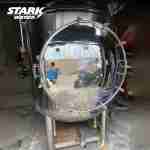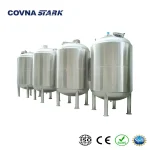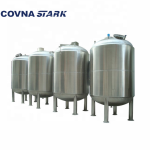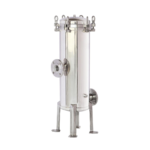Introduction: Why RO Feed Stability Starts with the Right Tank
A reverse osmosis (RO) system is only as stable and efficient as the water supply feeding it. While RO membranes are highly effective at removing dissolved solids, they are also extremely sensitive to fluctuations in pressure, flow rate, and feedwater quality. One of the most overlooked causes of RO performance issues is an improperly designed feed tank system.
Many industrial operators focus on the membrane specs or chemical dosing setup, but fail to realize that unstable or poorly buffered feedwater can lead to membrane fouling, inconsistent permeate quality, and even premature system failure. A well-designed RO feed tank system does more than store water—it regulates supply pressure, buffers hydraulic surges, and protects your membranes from unnecessary stress.
This article will guide you through the key components and design considerations for building a reliable RO feed tank system—whether you’re planning a new installation or troubleshooting an underperforming one.
Common Issues Caused by Poor RO Feed Tank Design
An improperly sized or configured RO feed tank system can cause a wide range of performance problems—even when the membranes and pretreatment equipment are correctly specified. Below are the most common issues we see in the field when feed tanks are not designed for stability and flow control:
- Pressure Fluctuations: Inconsistent inlet pressure can lead to unstable permeate quality, reduced rejection rates, and shortened membrane life.
- Pump Short Cycling: Without sufficient buffer capacity or pressurization, booster pumps may start and stop frequently, causing wear, energy waste, and noisy operation.
- Hydraulic Shock: Sudden flow surges from direct feed or poorly placed pumps can damage membranes or connectors within the RO system.
- Water Hammer: Without a pressure tank or controlled feed, flow interruption and restart can create damaging pressure spikes.
- Contamination Risk: Using open-top tanks or low-grade plastic tanks introduces risks of microbial growth, debris, or chemical instability in the feedwater.
In short, when the RO feed tank system is treated as an afterthought, the consequences can ripple across the entire water treatment line—impacting efficiency, water quality, and maintenance costs.
Key Components of a Stable RO Feed Tank System
To ensure consistent pressure and flow into your RO membranes, your feed tank system should be more than a simple container. A well-engineered setup includes both structural and control elements that regulate supply, prevent shocks, and maintain hygiene standards.
1. Primary Storage Tank (SUS304/SUS316L)
This is the main holding tank, ideally constructed from stainless steel (SUS304 or SUS316L) for corrosion resistance and sanitary compliance. It should include a sealed top, sterile breather valve, and bottom outlet designed for complete drainage.
2. Inline Pressure Tank
A pressure tank placed between the feed tank and the booster pump helps absorb flow surges and ensures a steady inlet pressure. This reduces the cycling of pumps and protects membrane elements from damage due to sudden flow changes.
3. Level Control System
Float switches or ultrasonic sensors help maintain ideal water levels and prevent pump dry run or overflow. Automatic level control also stabilizes system inflow and keeps pre-filtration consistent.
4. Optional: CIP Port or Spray Ball
For systems requiring frequent cleaning or hygiene compliance, a built-in CIP port or spray ball ensures internal cleaning without tank disassembly—critical for food, beverage, and pharma-grade applications.
Explore our recommended components here:
STARK Stainless Steel Water Tank and Pressure Tank Collection
Recommended System Layout for RO Feed Stability
To optimize flow and pressure conditions entering your reverse osmosis system, we recommend the following configuration, which balances storage, pressure, and control in a compact and hygienic design:
Typical Flow Layout:
Raw Water → Pre-Treatment → Stainless Steel Feed Tank → Pressure Tank → Booster Pump → RO System
Design Rationale:
- Feed Tank: Sized to handle at least 30–60 minutes of buffer volume; equipped with sealed top, vent valve, and drain outlet.
- Pressure Tank: Installed downstream of the feed tank to maintain constant input pressure to the pump, reducing mechanical wear and TDS fluctuation.
- Booster Pump: Operates with fewer start-stop cycles due to pre-pressurized water availability.
- Optional Level Sensors: Enable automation, overflow protection, and pump dry-run prevention.
This design minimizes hydraulic shock, reduces membrane fouling risk, and simplifies daily operations. It’s scalable for both small-scale commercial RO units and large industrial systems.
Looking for system drawings or layout suggestions tailored to your application?
Contact our engineering team for technical support.
Real-World Example: Beverage Plant Improves RO Performance with STARK Feed Tank System
A beverage manufacturing facility in Southeast Asia experienced frequent TDS fluctuation and pump cycling in their 2 m³/h RO system. Their original setup included a 2,000-liter open-top plastic tank connected directly to the booster pump.
Upon site assessment, the STARK engineering team identified three key issues:
- Unsealed tank exposed to airborne contamination and temperature swings
- Inconsistent inlet pressure caused membrane fouling and flow spikes
- Booster pump short-cycled more than 100 times per day
STARK Solution: We replaced the plastic tank with a SUS316L stainless steel feed tank featuring a sealed top, sterile breather valve, and conical bottom. A 150L inline pressure tank was added to regulate flow before the RO membrane. Liquid level sensors and auto pump control logic were installed for complete automation.
Results after 3 months:
- TDS fluctuation reduced by 80%
- Pump start frequency decreased by 65%
- Membrane cleaning interval extended from 2 weeks to 2 months
This case demonstrates how a properly designed feed tank system improves both water quality and equipment longevity—without the need to replace the RO unit itself.
Conclusion: Design for Flow, Not Just Volume
In reverse osmosis systems, a feed tank isn’t just a storage container—it’s a dynamic component that directly affects membrane performance, energy efficiency, and operational stability. Choosing the right materials, integrating a pressure tank, and controlling water level are all essential to maintaining smooth, consistent system operation.
Many of the issues operators face—TDS fluctuations, pump damage, fouling—can be traced back to poor feed tank configuration. Instead of upsizing your RO system or replacing membranes prematurely, consider whether your feedwater design is up to standard.
At STARK, we design and supply complete RO feed tank solutions that combine sanitary stainless steel construction, inline pressure regulation, and automated level control. Whether you need a compact 500L system or a multi-stage buffer with integrated pre-filtration, we’ll help you optimize flow from the source.
Need help selecting the right RO feed tank system?
Contact our team for free technical guidance, layout drawings, and tank recommendations tailored to your project.





